Syria Civil War key points -- compiled from reputable internet sources, CNN, BBC, UN etc.
by John Davenport, Fordham University, Department of Philosophy (davenport@fordham.edu) -- last update Dec.31, 2016
[See the final section for political analysis, critique, and recommendations]
The Syrian civil war, now in
its fourth year, is the largest humanitarian crisis in the
world. Its direct effects, now combined with the effects of
ISIS offensives, have caused over 12 million refugees
to flee their towns in Syria and Iraq combined -- the largest
since World War II.[1] While most of these
refugees remain in Turkey, Lebanon,
and Jordan, over a million have made their way to Europe
between 2013 -2016, including over 350,000 in 2015 alone: see
http://www.bbc.com/news/world-europe-34131911

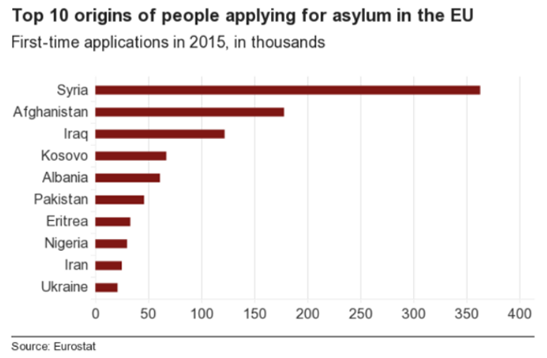
The death toll in within
Syria has now topped 400,000 (up
from 200,000 in April 2014)[2] -- over 3 times
the casualties in the conflict in Bosnia in the early 1990s, which NATO nations and
human rights leaders around the world viewed as sufficient to warrant serious military intervention to stop the slaughter. This 400,000
figure does not include Iraqis, Kurds, Yezidis,
Christians, and other minorities killed by ISIS advanced in
Iraq, which are largely a result of the Syrian civil war (see
below). Many residents in western nations do not understand
that most of these victims died by being buried in rubble of
bombed buildings -- often dying slowly from injuries and lack
of water while buried alive, as in a factory or mine collapse.
The horror is beyond description. Most victims in Bosnia,
Darfur, and even Rwanda at least enjoyed swifter deaths. See
http://www.iamsyria.org/death-tolls.html for a higher estimate
of casualties to date:
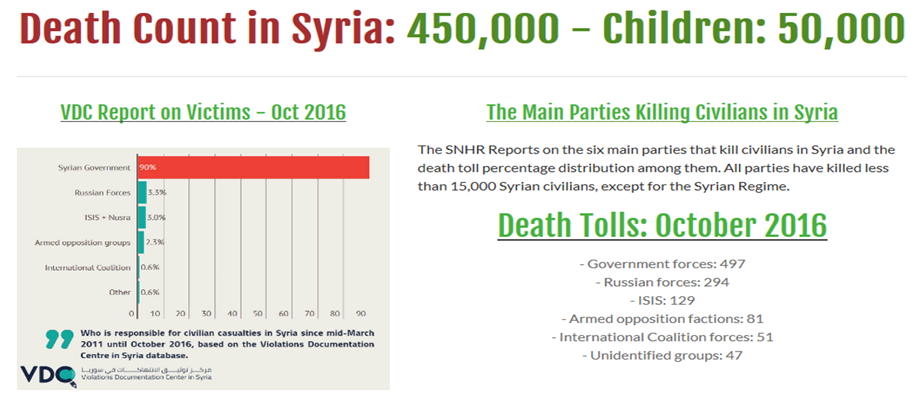

Sources differ on the figures; for example the Syria Center for Policy Research reported a high figure of 470,000 in Feb. 2016, implying that over half a million must have been killed by the end of 2016:http://www.pbs.org/wgbh/frontline/article/a-staggering-new-death-toll-for-syrias-war-470000 . But I generally regard the Syrian Observatory for Human Rights figures as the most reliable, because it has literally tallied the body count day by day since 2011: see http://www.syriahr.com/en/. They are certain that direct deaths from fighting by Oct. 2016 top 350,000 -- which does not include those dying later from injuries or disease due to the conflict. See http://www.syriahr.com/en/?p=50612 which gives a 430,000 total figure. Also see this IB times update: http://www.ibtimes.com/syrian-civilian-death-toll-2016-isis-assad-regime-fuel-refugee-crisis-growing-war-2415265
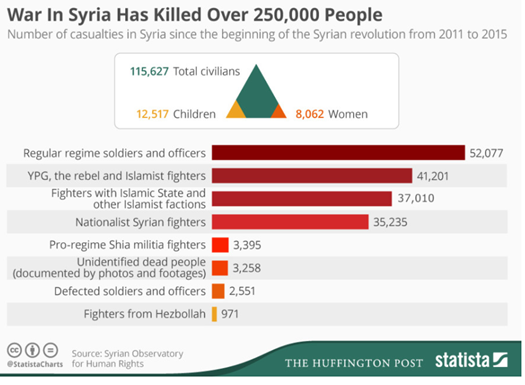
The death toll in Aleppo alone
during the second half of 2016 has probably topped 20,000,
with many schools and hospitals intentionally targeted by
Russian aircraft and regime bombers: see
http://www.nytimes.com/2016/09/28/world/middleeast/syria-aleppo-children.html?_r=0
and
http://www.aljazeera.com/news/2016/09/letter-aleppo-city-death-toll-160928055621630.html
. There are no working hospitals left in eastern Aleppo:
http://www.foxnews.com/world/2016/11/20/children-among-dozens-killed-in-latest-aleppo-attacks.html
. Russian strikes alone have killed over 10,000 around
Syria since they began in October 2015.
As the Huffington Post analysis from 2015 suggests, most of the
casualties have been among civilians and armed groups opposed
to the Assad regime. A conservative estimate would put at
least 2/3 of the casualities
among the Sunni majority, with less than 1/3 among
Assad's forces and the ruling Shi'a
minority population, along with other allied minority groups
(Syrian Christians, Druze, etc). The Syrian army and allied
groups are known to have at least 100,000 dead -- i.e. most of
the dead on the regime side were soldiers, not civilians. That means that at least 267,000 or
more of the dead are Sunni -- the people
served by the rebellion, and increasingly driven by
desperation to join Al Nusra or ISIS..
With Putin using Russia's forces to bomb Assad's opponents in
Aleppo through the end of 2016 and eastern suburbs of Damascus in earlu 2017, and Iran's hardliner military also
defending Assad, the roughly 80,000 more moderate Sunni rebels
opposing both ISIS and Assad and 50,000 Kurdish fighters
opposing ISIS (and unfriendly to Assad) are unable to win.
Eastern Aleppo was the last stronghold of the rebellion, and
it has now been largely leveled and retaken. The smaller city of Idlib will doubtless be next, while Obama's lame-duck administration continues to support fictional ceasefires. The only solution
is a multinational coalition determined BOTH to rid Syria of
Assad's tyranny and to destroy ISIS. One cannot
happen without the other. Moderate Sunni leaders can be left
in control of parts of Syria when both Assad and ISIS are
gone. (See detailed recommendations in the last section
below).
The Decisive Error in summer 2013. The crucial decisions made by
western nations in late August and September 2013 not
to launch air strikes against the Syrian regime in response to
its proven use of chemical weapons-tipped missiles against its
own citizens on the outskirts of Damascus proved to be a
critical turning point, allowing Assad's forces to continue aeriel bombardment that has devastated
more areas of large cities like Homs and Aleppo where Sunni
civilians once lived. The regime's entire strategy is now one
of scorced earth, with the goal
of driving as many Sunni residents as possible away. Syria was
a nation of 23 million before the regime started this war by
killing and torturing protesters, including many children, in
2011. Over a 1/4 of that population has now left Syria
completely, becoming foreign refugeees,
and almost 1 out of every 60 citizens has been killed. Of
course many more are seriously mained, wounded, suffering
extreme trauma, stripped of virtually all prior possessions
and home, etc.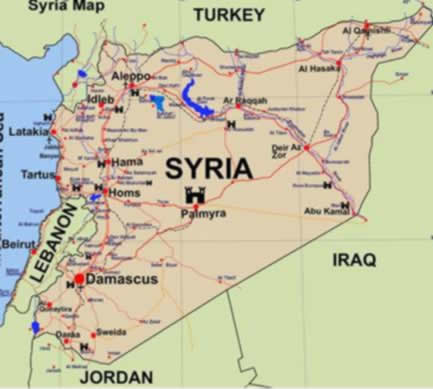
A Brief History, with atrocities highlighted
Bashar al-Assad has been president
since June 2000 when his father, the former president, died.
He led the Baathist party in
Syria, an ostensibly secular/communist party allied with
Saddam Hussein in Iraq. In the 1960s and 1970s, this party
became dominated by the Alawite
minority group in Syria (an extreme wing of Shi'a Islam), while Hussein and his
relatives were Sunni. In both nations, the minority groups
ruled the larger majority (of Sunnis in Syria, and Shi'a in Iraq). The party in Syria was
led by Hafez al-Assad who ruled Syrian from 1971, succeding
prior military leaders who took over by coup after the French
colonial powers left in the 1960s.
· The Assad regime is therefore aligned with the Shi'a factions in Lebanon, principally Hezbollah; and it has often exerted control over Lebanon.
· Other minority groups such as Druze, Catholics, and Orthodox Christians in Syria have come to rely on the Shi'a minority government as well.
Protests begin: in Feb 2011, the first protest was held in the capital asking for reforms was inspired by the Arab Spring uprisings in Tunisia and Egypt. Further protests against the government spread from Damascus to Homs and the southern city of Deraa, often after Friday prayers. These were entirely peaceful marches, but they were mainly by people from the Sunni majority in Syria. They were also led by people who supported a secular regime, with no intent to establish a Sunni religious government.
By mid-March, the regime
started responding with violence, shooting a few protesters,
and their funerals became new protest marches. Although Assad
initially sent a delegation to apologize for deaths in Deraa (also spelled as "Dar'a"), his
forces fired into a crowd on March 18, leading protesters to
burn down a local Baathist party
office. The protesters increasingly call for democracy in
Syria and an end to four decades of "emergency rule" by
decree. By late March, it looked like the Assad regime might
consent to some small reforms: see the Britannica article:
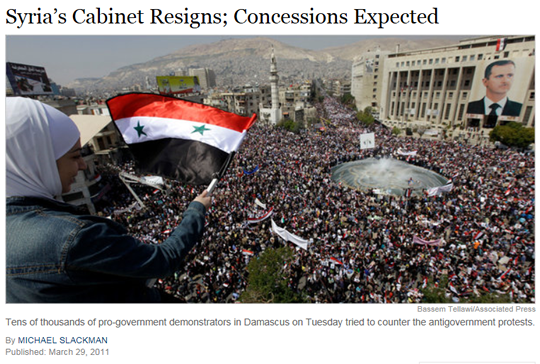 https://www.britannica.com/event/Syrian-Civil-War: "However, as protests
intensified and spread to additional cities, there was an
escalation in the use of violence by Syrian security forces.
On April 8 security forces opened fire on demonstrators in
several Syrian cities, killing at least 35 people. Amid
reports that the death toll since the first protests in March
had exceeded 200, international condemnation of the Syrian
government mounted, with human rights organizations and
foreign leaders calling for an immediate end to violence."
https://www.britannica.com/event/Syrian-Civil-War: "However, as protests
intensified and spread to additional cities, there was an
escalation in the use of violence by Syrian security forces.
On April 8 security forces opened fire on demonstrators in
several Syrian cities, killing at least 35 people. Amid
reports that the death toll since the first protests in March
had exceeded 200, international condemnation of the Syrian
government mounted, with human rights organizations and
foreign leaders calling for an immediate end to violence."
More people were killed at massive protests near the Omari Mosque in late March, as the protests starting topping 100,000 people. The regime released 260 political prisoners in late March in attempt to appease the protests, but the protests continued into April with more police shootings and arrests of protesters ramping up, including hundreds of arrests in Baida.
· After the alleged end to emergency rule on April 21, enormous protests across 20 towns on April 22 led to further crackdown. Security forces killed at least 75 people after Friday prayers.
· People were naturally infuriated by continued police killing of protesters, called more and more for an end to the Assad regime rather than merely political reforms towards democratic rights.
The regime's crackdown
· Deraa was surrounded by tanks in late April with thousands of troops, first snipers on rooftops. Over 250 killed and hundreds of protesters arrested in their homes. Food and water supplies to Deraa were cut off through May in effort to starve protesters out.
· Douma, a poor suburb of Damascus,
was also encircled and political arrests carried out at
hundreds of homes.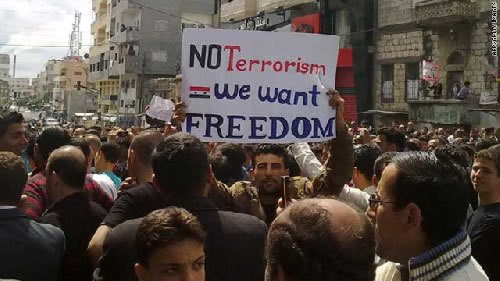
· By early May, Baniyas and Homs were also besieged: tanks surrounded the Sunni-majority areas and police carried out waves out house searches and mass arrests. The same pattern was repeated in other towns and suburbs in May.
· The bodies of arrested protesters began to come back to their families dead, and showing signs of torture -- including horrific injuries to teenage boys (eyes gouged out, kneecaps broken, genitals cut off, etc). A video of a 13 year old boy's mutilated body circulated on YouTube. I have been directly told by Syrian leaders in the US that in May 2011, Syrian officials came to the homes of their relatives in eastern Damascus suburbs to tell them to forget that their captured teenage sons ever existed, as they would never see them again.-
· A UN report later assessed that thousands of children were arrested and detained with adults by the regime in 2011 and 2012. Many were raped or tortured. Many children were also killed and maimed by army attacks on anti-government protests.
· Soldiers who refused to fire on protesters began to be executed by the regime.
· By the end of May the regime
was using machine guns on homes in Talbisha.
· Following a June 6 attack on Syrian soldiers in Jisr al-Shughūr, the regime launched attacks on protesters in that town, killing at least 100 and driving thousands to flee.
· It was at this point that some protesters understandably began to call for armed resistance.
· Mass funerals were held in early June, but by later in 2011, funerals for dead protesters had to be held at night or in secret to avoid attacks by government snipers targeting mourners. Yes that's correct: Assad and Shi'a militia commanders instructed snipers to shoot at Sunnis trying to bury their dead.
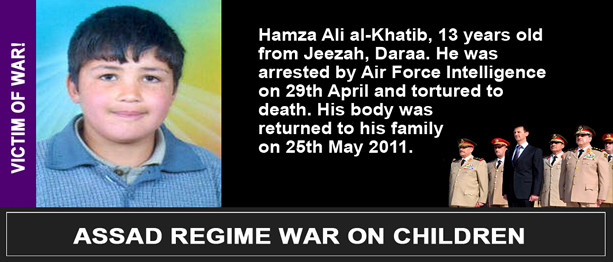
Escalating regime violence and refugee crisis begins in 2011. By mid-June 2011, helicopter gunship attacks on northern towns had sent thousands of refugees towards the Turkish border. Iranian elite troops had joined their Shi'ia comrades to help the regime's attacks. Regime troops initially tried to prevent refugees from crossing into Turkey.
· By mid-June, the Syrian National Council had been organized to lead now self-proclaimed "revolution" forces against the regime.
· Enormous protests in Hama, over 200,000 near the end of June, still produced no response other than attacks by the regime.
· On July 1, over 500,000 protested in Hama, with many thousands also protesting in Damascus. But the regime sent tanks towards Hama in response.
· July 7: the French and US ambassadors joined a similar protest of over half a million in Hama.
· The numbers grew even larger in protests throughout Syria during July, finally prompting UN condemnation of human rights violations by the regime in early August.
· On August 8, the King of Saudi Arabia condemned the Assad regime, withdrew ambassador.
· Egypt also condemned the Assad
regime, but Assad began to call all the native protestors in
Syria "terrorists" and "foreign agents," a rhetorical device
that continues to this day. Russians have now joined in
calling any and all opponents of Assad "terrorists" (thus
reducing a crucial term to meaninglessness).
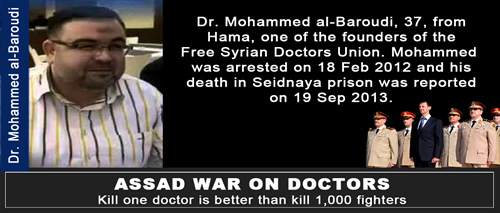
· The regime also besieged the port of Latakia, attacking firing on it from ships as well. The port was then invaded by ground troops sweeping from house to house.
· On July 29, a group of defecting army officials formed the Free Syrian army to respond to the regime's violence. This was after deaths among protesters had reached over 5000. The FSA grew to 20,000 strong by December, and double this by July 2012. Many of its members had been ordinary citizesn -- bakers, mechanics, lawyers, civil servants etc; they were not religious hardliners. But unfortunately the FSA had no single leadership until Dec.2012 and was never able to control all the groups fighting against Assad. Its control has weakened as it lost ground after spring 2013 (see below). It was reconstituted as the Syrian Democratic Forces on Oct.11, 2015 -- a group explicitly opposed to the Islamist extremist Sunni militias.
· By Aug.18, 2011, Canada, France, the US, Germany, and UK all called for Assad to resign. But Putin began to ramp up his support, flying in more arms and supplies to the Syrian army.
· By late August, Russia and China began pressing western nations not to intervene in Syria's "internal affairs" -- the code word for absolute state sovereignty no matter what the regime does, i.e. no matter how extreme its violations of individual human rights.
· By September 2011, the FSA and
Syrian army were engaged in a pitched battle in Rastan. Here as elsewhere the FSA
would be forced to withdraw.
An arms embargo and other sanctions by the EU came into force
to try to put pressure on Assad.
For more details on torture of prisoners by Assad, I suggest this website: https://humanpains.com/2015/02/28/stop-assad-killing-children/
Mounting Atrocities: Sept. 2011- Dec. 2012.
 Nov.2011: A pitched battle for
control of Homs, followed by a siege from Assad forces
surrounding rebel areas, and indiscriminate shelling of
civilian houses from aircraft, such as the helicopter shown
here dropping barrel bombs on apartment buildings.
Nov.2011: A pitched battle for
control of Homs, followed by a siege from Assad forces
surrounding rebel areas, and indiscriminate shelling of
civilian houses from aircraft, such as the helicopter shown
here dropping barrel bombs on apartment buildings.
-- Tareq-al-bab was bombed on Dec. 28, 2012.
--This strategy set a pattern seen ever after in the war, with whole families buried beneath ruins, people including children dying after days of terrible suffering under piles of rubble that could not be moved by rescuers in time.
-- The targeting of civilian apartments and houses in these attacks is intentional, not merely a result of missed targets by fast-flying aircraft. Increasingly from mid-2012, Assad's helicopters have dropped barrel bombs directly on housing.
-- At the same time, tanks and
rocket fire from Assad infantry have been directed at parts of
towns held by opposition until they are reduced to rubble.
-- Irregular militia forces from Alawite groups loyal to Assad
also carried out other massacres, such as over 100 butched in
Houla in May 2012, including at least 32 young children (see
rows of corpses in photo below; the photos of the children are
too graphic to show).
-- Understandably, these tactics have produced a level of rage among Sunnis both in Syria and beyond that has partly redefined the original purpose of the rebellion.
April-July 2012: while Kofi Annan was trying to broker a ceasefire on behalf of the UN, the regime stepped up attacks and large-scale executions. Alawite militias with the blessing of the regime began attacking vulnerable targets, killing Sunni civilians by scores at a time. The Houla Massacre was just the best publicized: which over 100 were gunned down and their wrapped bodied found as a warning to others. Another 85 were killed in Al Qubeir. Attacks on rebel positions mounted in parts of Damascus and the second largest city, Aleppo. Parts of these towns, like Homs, were divided with regime snipers posted on high floors of buildings to shoot at civilians trying to cross from rebel-controlled areas -- more direct targeting of civilians.[3] People had to cross these kill-zones to get vital food, medicine, or other supplies.



Rebel Offensive and the Beginning of ISIS: despite all these terror
tactics from Assad, the rebels made progress in major cities
and began pressing south from Turkey in the north, taking
control of more territory in the north of Syria from Nov 2012
- April 2013. For a while they had success taking various army
bases and one large air base. They eventually captured the
north-central city of Raqqa (now
taken over by ISIS).
But by late 2012, many fighters
from other Sunni nations had come to Syria to help the
rebellion, including some from more extremist (jihadist or
fundamentalist) groups such as the Al Nusra
front and the Islamic Front and later ISIS (the "Islamic State
in Syria" or ISIL = "the Islamic State in the Levant"). The
Free Syrian Army units found themselves working alongside, and
increasing in tension with, more religiously-driven militias
not under their command.
· Some of these ISIS leaders had been military in the Sunni regime of Hussein in Iraq, and had been released from US prisoner-of-war camps in Iraq (famously including Al-Bagdadi, the top commander of ISIS). As Peter Neumann argued in the London Review of Books in April 2014, other jihadi leaders who helped populate ISIS had been invited in by Assad's government itself as part of various strategies, including sending extreme Salafists into Iraq to fight the US forces there. Assad was especially concerned that after Hussein's Baathist regime was ousted, that his own Baathist regime would be next.
· But 2013, then, Western governments had waited too long to the moderate Sunnis, leaving extremist Sunni elements to fill the void. Ever since, this has given opponents of intervention a new reason to hold back: now any arms sent to the rebels could fall into the hands of Al-Qaeda-linked groups.
· Kurds in northeastern Syria would eventually fight against some of these Sunni extremist groups in 2013 too, while remaining neutral towards the Assad regime. Kurdish forces since 2013 have increasingly fought against ISIS control in northeastern Syria.
· This rise of extremist groups not allied with the original (more moderate Sunni) rebels in Syria is partly a result of the rage occasioned by Assad's atrocities. But it is also partly an intentional strategy by Assad to make it look like his opponents are all Al-Qaeda-style "terrorists," as the Assad regime constantly calls all of its opponents.
· Thus Simon Cordall has reported in Newsweek (June 21, 2014) that in mid-2011, Assad starting releasing from his prisons many of the leaders of ISIS, and even facilitated their work.
· By early 2012, despite its break with Al Qaeda (which considered ISIS too extremist!), ISIS had doubled its ranks to 2500.[4]
· This made great PR for Assad and forced the Free Syrian army and other rebel groups originating from the moderates who led the rebellion to fight foreign Sunni jihadists on one side while fighting Assad's forces on the other. The FSA advances thus slowed in late 2012.
Hezbollah Enters Qusayr and massacres begin. Moreover, Lebanese Shi'a
radicals entered the fight to help shore up Assad's weakening
regime. By April 2013, Hezbollah sent over 7000 fighter into
Syria from Lebanon: they pressed north from the border to take
the critical town of Qusayr,
driving rebels back in intense fighting. Rebels later retook Qusayr, but by June the regime it is
irregular militia allies had full control of the town again.
The atrocities against Sunni civilians who were stuck in the
town were extreme. Similar massacres of innocent Sunni
civilians followed when Hezbollah fighters and Alawite militias entered Al Bayda and then Baniyas.
The BBC showed video footage taken by the attackers for
bragging purposes in which scores
of men and boys shot execution-style and all lined up for
counting. The videos
also show many families shot at point blank in their homes,
and many other homes torched with the residents still inside. In a BBC interview,
women who survived these massacres describe the house-to-house
butchery of trapped civilians, with many burned alive in their
homes. See Ian Pannell's May 28 report:
http://www.bbc.com/news/world-middle-east-22684359
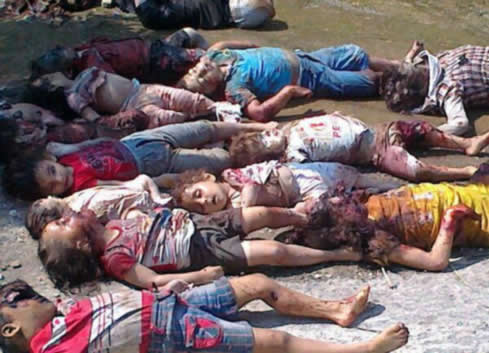
According to the Wikipedia timeline: "the multiple video images that residents said they had recorded in Al Bayda and Ras al-Nabeh – particularly of small children, were so shocking that even some government supporters rejected Syrian television's official version of events, that the army had simply "crushed a number of terrorists." Massacres of hundreds of Sunnis at a time were reported in May - August 2012 in other Syrian cities.
- the atrocities committed by Hezbollah fighters in this offensive were so bad that Hamas, the group leading most (Sunni) Palestinians in the Gaza Strip, ended its long-time alliance with Hezbollah because of it.
- the Guardian reports more than 500 slaughtered in Daraya in southern Syria in 2.5 days in late August 2012, probably in part by non-uniformed gangs of regime sympathizers (shabiha).[5]
- reports indicate that Shi'a fighters from Iran and Iraq had also joined the regime forces in these attacks to retake a key line of towns stretching north.
Chemical attack and the
West's Abortive Almost-Response. During 2013 the regime had
started using Scud missiles to attack rebel positions. The
bitterest fighting during the turning point of the war (going
against the rebels) involved the infamous launching of
chemical weapons-loaded missile at the Ghouda
suburbs outside Damascus to clear out opposition before a
regime offensive into the area. The US reported 1429 killed in this chemical
attack (BBC 2/27/2014).[6]
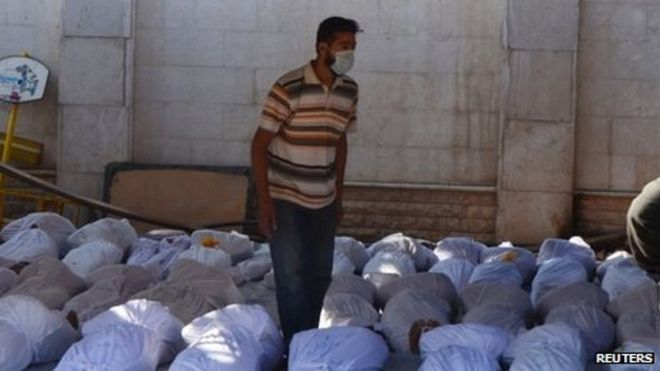



1. The American government responded by pushing the charge of chemical weapons use as the UN investigation began. During the last days of August 2013, the tide almost turned back against the regime as a result. In France, President Hollande finally called for air strikes on Assad. Obama agreed an went on television to say the red line had been crossed and to call for a military response. But he first looked to support from the UK to complete the deal. The British Prime Minister David Cameron called for a vote in Parliament, fairly confident of winning by a slim majority.(See reports on US intelligence about the chemical attacks, such as: http://www.nytimes.com/2013/08/31/world/middleeast/syria.html ).

2. But then, in a move that should be recalled in infamy forever, the leader of the British Labor party Edward Miliband, sensing a chance to embarrass Prime Minister Cameron and thus advance his own political career,[7] decided to hijack the effort to unite a coalition to stop Assad. Taking Cameron by surprise, he pulled out all stops to convert as many Labor, Liberal and some Tory MPs to his side to vote against intervention. He was joined by Crispin Blunt, former Tory head of Military Affairs, who opposed intervention even after the chemical attacks. Cameron lost by four votes, while several of his own MPs including six of ministers in his government, had not made it back to Parliament for the emergency session (not thinking they would be needed). This proved to be a turning point in world history. The next day on August 30, perhaps belatedly realizing that he had destroyed the best chance to stop Assad in the history of the war, Miliband cynically suggested that we should find "other ways" to help the Syrian victims.[8] There have proven to be no other ways: by Dec. 2016, over 350,000 have been killed since Miliband's stunt: this is blood partly on Edward Miliband's hands forever.
- The Deputy Prime Minister and head of the Liberal party Nicholas Clegg blamed Miliband for cynical opportunism, putting his own career ahead of the interests of justice in response to the atrocities committed by Assad and his (then) 100,000+ victims.[9]
- Some sources have even accused friends of Miliband in the Socialist Action group of being friendly towards the Assad regime, perhaps because the Baath party was at one time a socialist party.[10] While I doubt accusations that Netanyahu's regime put Miliband up to this disasterous action, it unravelled the one effort that almost led to serious western action against Assad. This is a man who says on his webpage that he believes we have "a duty to leave the world better than we found it." He has done quite the opposite.
- Moreover, some aid groups and NGOs argued against military intervention. Shockingly, Oxfam issued an official letter in September 2013 during the height of the debate explicitly opposing air strikes.
- MSF issues a letter denying
its earlier report that it could confirm a chemical attack
because it feared this would be used as an argument for
military intervention. Fabrice Weissman, a leader of
MSF-France, has also openly opposed the UN's 2005
Responsibility to Protect doctrine, insisting that
"peaceful" methods will be more effective. We have yet to
see any evidence of this.
- But Miliband's action and the rest of the "anti-war" effort
in Britain in August 2013 succeeded in sowing mass confusion
among British voters.
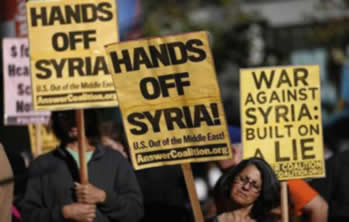
- In the US, anti-war campaigns portrayed the planned strikes on Assad as "war on Syria" rather than war to save Syrians from an insanely tyrannical, utterly diabolical ruler. A good example is the typically unnuanced position of the undiscriminating pacifict "Answer Coalition" on the Syria issue. They also share the blood of 300,000 now, yet they proudly brag about their actions on their website.
- In the face of all this, Obama wavered and showed weakeness, against the advice of his own foreign policy experts -- Hillary Clinton, Samantha Power, Susan Rice, and others. The Atlantic reported that Obama decided on Aug.30 to "call off planned air strikes against the Syrian government" without consulting anyone but his chief of staff. In this article, Niall Ferguson correctly notes that the "consequences of American non-intervention in Syria have, in some ways, been as bad as the consequences of American intervention in Iraq."
- See similar evidence of
arrogant overconfidence in Obama's interview with Jeffrey
Goldberg.
3. In the face of such popular ignorant opposition, the western
plan to stop Assad totally unraveled. Obama sensed danger and publicly
said that he might call for a vote in Congress as well. Public
opposition in a war-weary US mounted and it became evident
that more Republicans than initially expected might vote
against air strikes on Assad -- despite the fact that the
entire foreign policy establishment from Hilary Clinton, John
Kerry, Susan Rice and other leaders in the State dept had long
favored air strikes. Obama's weakness on this issue will be compared by history to Clinton's weakness during the Rwandan genocide.
4. Putin that scored his coup by proposing to broker a Syrian handover of their chemical weapons, giving Obama a way out. That process of handing over the Syrian stockpile began in late 2013 but since then, the Assad regime has simply shifted to using chlorine and mustard gas attacks instead, and chemical warheads are still being launched by Assad's forces to this day.
-- the Assad regime and Russia insist that as of mid-April 2014, 65% of the chemical weapons have been processed and moved to a Mediterranean sea port, but this port is still in Syria.
-- In April 2014, a few US
military commanders used this as a basis for arguing against
Kerry's renewed calls for air strikes, insisting that we need
to give more time for the chemical weapons to be moved out
first.
-- Of course the regime knew this and is stalling on the
chemical weapons for precisely this reason.
-- Since that time, the Assad regime has continued occasional
chemical attacks, including some in Aleppo during Oct. - Nov.
2016. But it has simply moved onto other chemicals such as
concentrated chlorine, and (of course) incendiary bombs, with their napalm-like effects.
Following the NATO nations' capitulation to anti-war public sentiment, the Assad regime was tremendously emboldened and began massive new assaults on Sunni cities in late 2013. A couple examples:
-- See the report on CNN titled "Syrian doctor: 'I lost count of the amputations' after assaults on Aleppo:" http://www.cnn.com/2013/12/22/world/meast/syria-aleppo-hospital/
-- See the report on the ballistic missile strikes on Tareq-al-bab, northeast of Aleppo throughout 2013: http://www.independent.co.uk/news/world/middle-east/video-before-and-after-satellite-images-of-aleppo-in-syria-show-human-rights-violations-8750496.html?action=gallery&ino=2
Assad's resurgence late 2013
- 2016.
Emboldened the failed efforts
of NATO powers to organize air strikes on Assad's forces, and
by continuing Russian material support, the Assad regime and
its Hezbollah allies (with paramilitary gangs of Alawite fighters and some militias from
Iraq too) made progress against the rebels in late 2013,
once again staving off Assad's defeat
- As a result, the Assad
government made no substantive offers at all during the
Geneva peace conference organized by the US and Russia in
Jan. 2014. As Ambassador Ford has explained, the
representatives of the FSA and other more moderate
nationalist groups opposed to Assad made a substantial
offer, in writing, at that Geneva conference to accept a
transitional government without any immediate requirement
for Assad to go. Yet the offer was ignored, and Russia and
Iran put no pressure on Assad's regime to negotiate in good
faith, because Assad's forces were doing so much better
after the failed effort to coordinate a western intervention
in Sept. 2013.
- The rebels fell into more
disarray, with the FSA having to fight off extremists from
ISIS who came into the void left by western nations via
non-intervention and took control of many areas east of
Syria's largest cities.
- By May 2014, there were increasing reports of fighters giving up on the FSA, while ISIS has attracted those more motivated by extreme religious ideology rather than the fight against Assad alone.[11]
- As Sunni jihadist militias
like ISIS and Al Nusra increased, Shi'a militias from Iran
also became more involved with supporting Assad. Although
the exact number is not known, thouands of members hardline
Iran's elite "Guard" (the Quds force), who support the
ultraconservative clerics in the Iran's ruling council, have
gone to war for Assad in Syria. As the BBC
reported on Oct.9, 2015, the Quds' commanding General
Soleimani has shuttled between Iran, Iraq, Syria, and
Russia, sending Iranians to bolster Assad's forces, and
helping the majority-Shi'a government in Iraq fight back
against ISIS.
- Robert Ford, US Ambassador to Syria from 2011 - 2014, has frequently reported that the Iranians organize, arm, and send into Syria in not only their own forces, but also Shi'a militias from Iraq, and Hezbollah fighters. The BBC report cited evidence that Iranian commanders have even organized some refugees from Afghanistan to fight for Assad, even though they do not want this job (and many seek to escape as refugees). Interviewing Ford for the BBC, Stephen Sakur also reported suggestions that Iran may send in a larger force if Assad's own army continues to weaken in this war of attrition.

1. The first siege of Aleppo areas in Jan - April 2014 took many thousands more lives and trapped civilians in areas without food or medicine for months before some relief came through a tenuous UN brokered humanitarian mission to deliver aid supplies.
-- The regime has used barrel bombs dropped from helicopters directly onto houses and apartment buildings to level areas of the city where populations friendly to the rebels are thought to live. These are large containers filled with explosives and metal shards (NYT 2/18/2014), a type of weapon made for indiscriminate killing of civilians.
-- On Feb.18, 2014, the NYT reported over 500,000 refugees on the move from Aleppo.
2. Thousands of Prisoners Murdered. In late 2013, a Syrian defector who was working in a coroner capacity smuggled out thousands of photos of dead prisoners, mostly captured protesters and rebels, many showing signs of torture. The UN report by war crimes prosecutors said that over 20,000 Syrians had been victims of execution, starvation in prison, and torture by the regime. Many of the murdered in these horrific photos look a lot like Holocaust victims. See the Human Rights Watch summary. But those photos extended only to August 2013, the point where the regime launched its second wave of major offensives after no western airstrike came. And these photos may not represent all victims prior to August 2013 either (thus we can imagine that more than 40,000 have probably suffered this fate from Assad's forces by now).
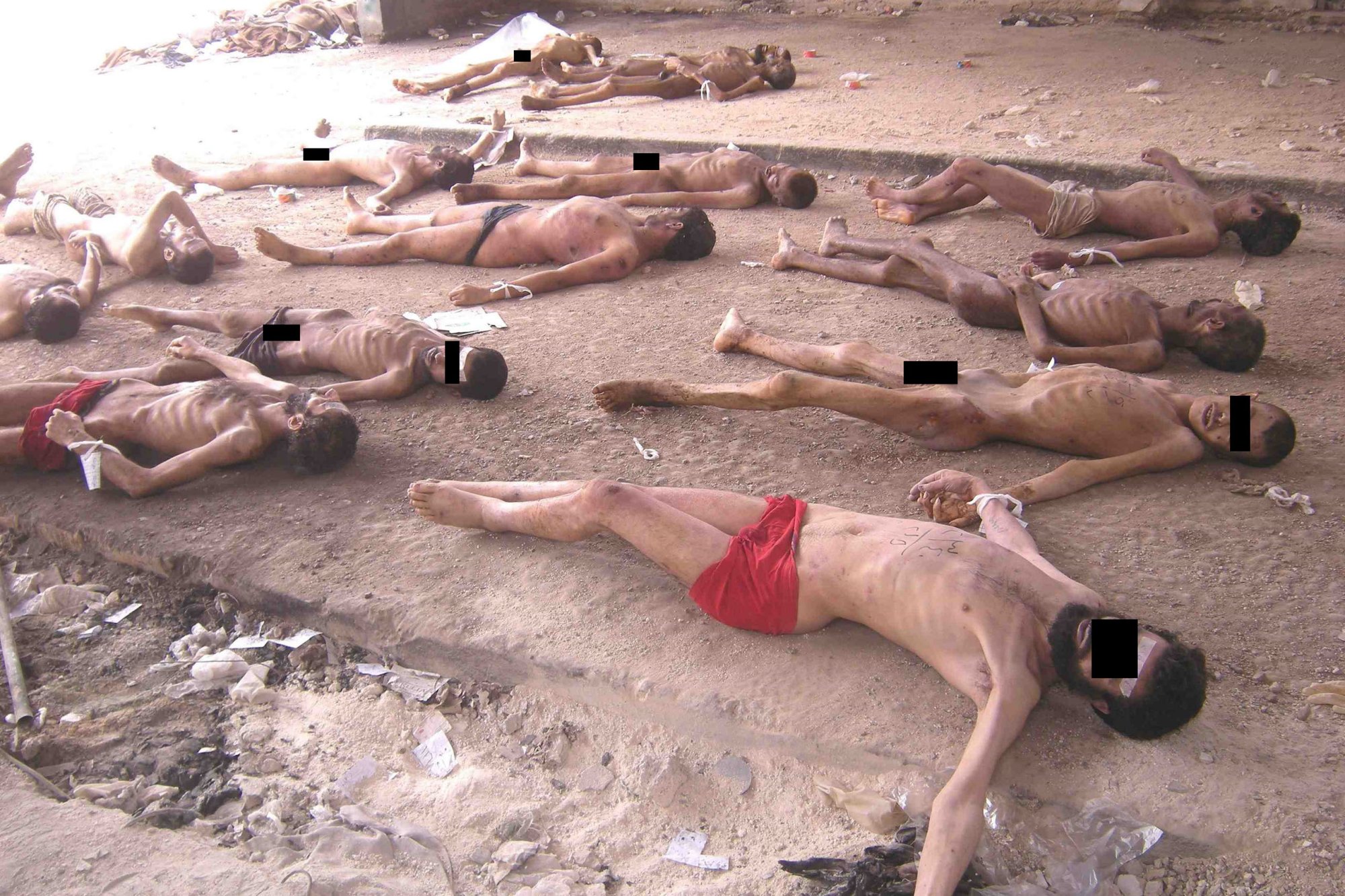
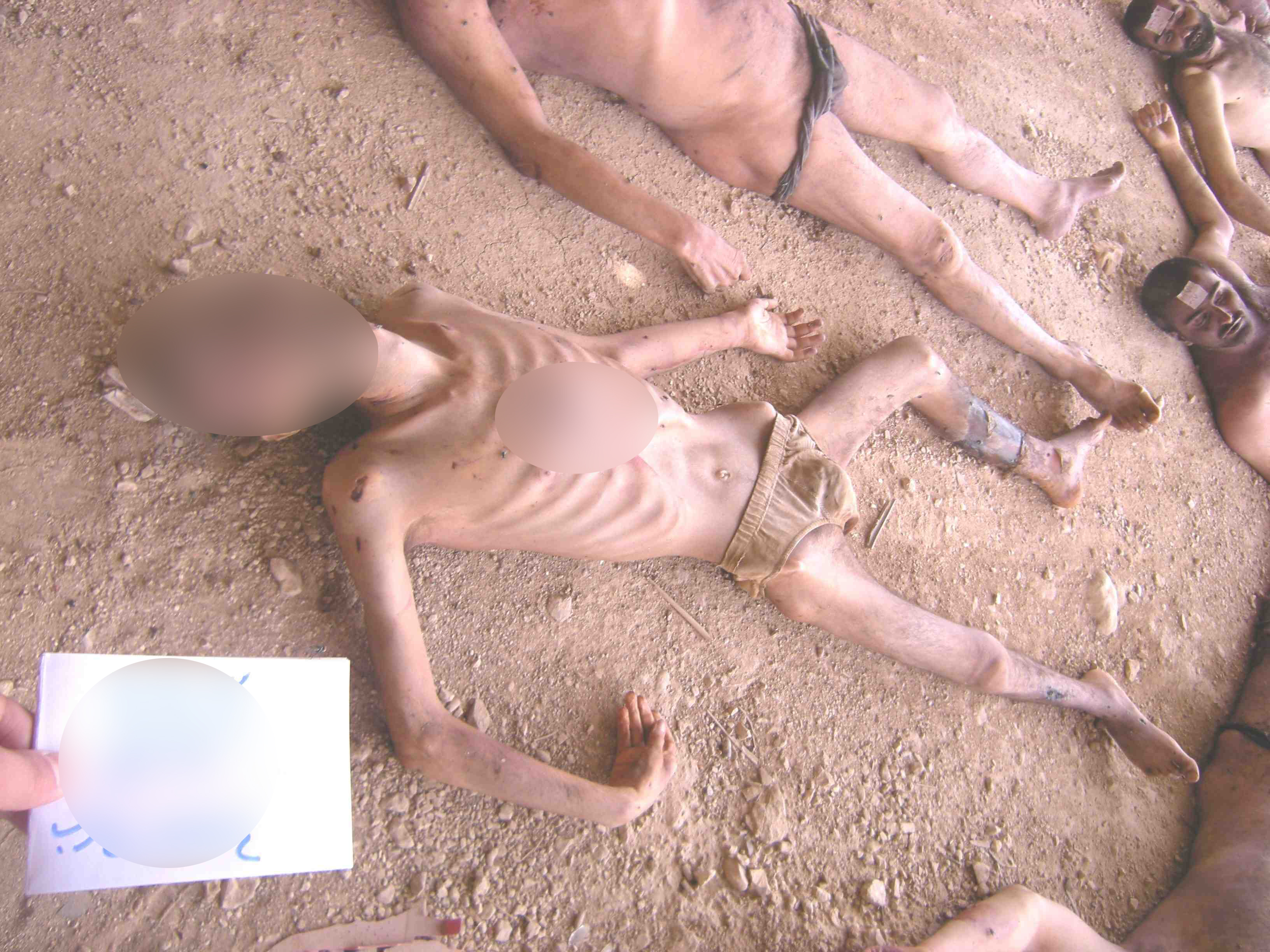
-- As with Rwanda and Bosnia,
if the conflict ever ends with the Assad regime overthrown, we
can expect western nations to go into high gear with judicial
proceedings, as if war crimes prosecutions after the fact
constitute the highest moral response available.
-- More confirmations of torture and mass executions came from
sources compiled in a UN report released in early Feb.2016.
-- Many tens of thousands have been arrested and held since
the conflict began, and thousands of these have "disappeared."
ISIS and the Islamic Front are also accused of torturing and
killing prisoners they have captured.
3. Two peace conferences in Geneva held during 2013 yielded no results because the Assad regime had no incentive to negotiate or concede anything, since it is winning. During Geneva II, the Assad regime killed over 2000 more Syrian civilians, many with bombs dropped from aircraft on Aleppo. The UN peace mediator resigned in protest at the intransigence of the Assad regime and its Russian backers. A Jan.2014 new round of peace talks failed for the same reason: no significant pressure on Assad or his allies.
4. In Feb. 2014, the Saudis
decided to give Syrian rebels badly needed antiaircraft
missiles, which could have hada major effect if they had ever
been delivered and deployed. Jordan has also decided to arm
Free Syrian Army rebels. With Iran's involvement, the conflict
has inched closer to becoming an all-out regional war between
Sunni and Shi'a groups.
5. The UN stopped trying to keep an official death count for some periods -- BBC 2/25/2014. However, drawing on the work of other groups, on August 22, 2014, the UN updated its estimate to 191,000 killed (including as many as 40,000 fighters from all sides). Around the same time, Syrian opposition websites reported about 114,000 people opposed to Assad (presumably mostly Sunni) has been killed -- or about 60% of the total. The Syrian Observatory for Human Rights reports about 41,000 deaths among Alawites, or approximately 20% of the total.
-- these figures are arrived at partly by adding up the death tolls of hundreds of particular conflicts, battles, massacres, sieges, and so on during the war.
-- but the UN figures do not
include death figures from the ISIS advance in Iraq (see
below).
6. The ISIS Offensive and
the Failed US Response
June -Sept. 2014: In June, having already taken
Raqqa and gained control of almost
a third of Syria in 2013, ISIS (ISIL, also known as "Daesh" by
its opponents) launched its major offensive into Iraq,
conquering much of the Sunni areas in the northwest and
pushing into Mosul, a major Sunni and Kurd city in the north.
Several divisions of Iraqi forces melted away before this
advance or perhaps 10,000 ISIS fighters, largely because too
many army officers were primarily loyal to Malaki (the Shi'a
prime minister) and cared little for Sunni and Kurd areas of
the nation. The US and Europe, like Middle Eastern nations,
did nothing to try to stop the ISIS forces from reaching Mosul
and taking over the city.
· from banks in Mosul, ISIS has gained millions in hard currency. It is also selling pirated oil out of the Mosul area and other regions into Turkey for profit.
· from fleeing Iraqi units, ISIS has also gained tanks and more heavy weapondry, including more rockets and some anti-aircraft missiles (shoulder fired).
· during the offensive, it captured thousands of their women and girls who have since been held as slave-brides for ISIS fighters.
· ISIS ranks have also been swelled by some Sunni men in areas taken, given their alienation from the Shi'a-led the Iraqi government, or their hatred of Assad and sense that ISIS would then be the only force capable of winning against Assad's regime. [Map from the BBC in mid-Sept 2014]:
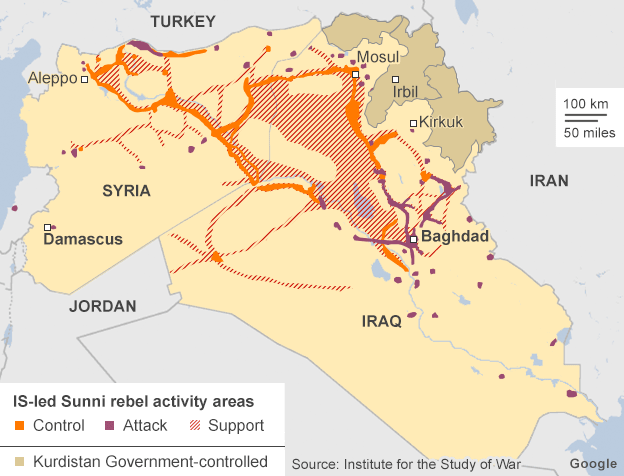
However, the Kurdish militias ("Peshmerga") fought back in northeast Iraq, and began to be supported by US airstrikes, especially after large portions of the Yezidi minority were driven from their homes up to an arid mountain on the Iraq/Syria border and had to be supplied and rescued by air to avoid total massacre by ISIS. The Mosul dam area has been retaken by Kurdish forces, and some Iraqi army units (together with Shi'a militias) have organized to defend Bagdad and begin slow pushes north and west from the capital, now that a new (supposedly more inclusive) government has been formed in Iraq.
-- The Kurds have continued to
be the most effective ground force against ISIS, but the US
and European nations have given them little serious military
hardware because of Turkey's fear of the Kurdish forces.
In fact, in summer 2015, Turkey even bombed Kurdish Peshmerga
targets, even while these Kurdish fighters are doing almost
all the heavy ground fighting against Turkey's enemy ISIS just
south of Turkey's border.

From Sept.18-21, 2014, ISIS advanced on the Kurdish area in the northeastern tip of Syria (where it meets Iraq and Turkey). The victims are the same Syrian Kurds who opened an escape corridor for the Yezidi who escaped northwest off the mountains west of Sinjir in Iraq. Estimates suggest that thousands of Kurds have been killed in this new ISIS advance, and many Kurdish villages taken and destroyed. The town of Kobane is surrounded by ISIS on three sides and Kurdish forces are having trouble defending it because the ISIS forces seized so much heavy weapondry (much of it American-made) when the Iraqi forces in Mosul dropped their equipment and fled. The lightly-armed Kurds cannot hold off ISIS troops in tanks.[13] More than 80,000 Kurdish refugees crossed into Turkey, which initially tried to stop them but then relented under global media attention.[14]
-- Still, the hatred between
Kurdish forces and the Turkish government has been another
critical division among the forces opposed to Assad. It helps
explain why Turkey was unwilling to fight ISIS forces directly
in northern Syria throughout 2014 and 2016, and has battled
Kurds as well as ISIS in 2016.
7. After two years of rejecting repeated recommendations from his foreign policy experts to arm the FSA and oppose Assad, President Obama decided to supply some arms and training to FSA forces, but mainly to oppose ISIS. The House of Representatives approved part of this measure on Weds Sept. 17, 2014. After bitter debate the Senate Foreign Relations Committee on the same day, the US Senate approved the same measure on Sept.18.
-- Some argued that the President's plan came too late, after FSA forces had been decimated by Assad's advances after Sept. 2013, partly with Russian weapons, and the rise of ISIS.
-- Secretary of State John Kerry rightly argued that the FSA and its allies have been fighting ISIS, and have even set up bases to command operations against ISIS and other extreme groups like Al Nusra. He believes the moderate FSA-aligned groups will grow if they receive support and become more successful.
-- Critics such as Senator John McCain, who is angry at Obama's refusal to strike Assad, argue that FSA forces will want to focus on Assad first, rather than ISIS first.
Assessment: McCain has been proven
correct: on Sept.30, 2015, Christiane
Amanpour on CNN and other news
anchors noted reports that the US has been unable to recruit
many soldiers for its training precisely because we will only
take those who pledge to fight against ISIS rather than
Assad! On Oct.1, 2015, Amanpour
noted that by contrast, Jordan has been able to train over
30,000 FSA fighters because it does not make this absurd
demand built into the US policy, which is so highly offense to
Sunni people who have lost more than 200,000 of their own to
Assad's atrocities. In sum, Obama's policy to resist ISIS
almost totally failed because
- he stubbornly refused to support Syrian forces determined to oppose Assad first.
- he insisted on using US forces only for air assaults, while the Russians have special forces on the ground in Syria helping Assad.
- he refused to fully support the Kurdish forces by arming them and pressuring Turkey and Iraq to give them their own nation in exchange for their enormous sacrifices in resisting ISIS.
- he has refused Turkey's call
for an all-NATO force to press south against ISIS.
he has negotiated a promising nuclear control deal with Iran, but not threatened any new US or NATO-nation sanctions against Iran for supporting Assad.
- the result is one of the worst US foreign policy disasters in recent history.[15]
McCain's point should also be
further generalized. Not only FSA forces, but Sunnis in areas
taken over by ISIS, and Turkey (which is 75% Sunni) could not
be persuaded to reject and fight against ISIS without some
credible promise to stop Assad, who has caused the death of
over 150,000 Sunnis in Syria, with thousands more falling to
ISIS. We cannot pretend that this is not a regional sectarian
war. Sunni nations like Jordan and Saudi Arabia are also
primarily concerned for other Sunni peoples. While their
governments do not like ISIS, some wealthy donors in these
nations currently see ISIS as the only counter-weight to Assad
despite their incredible brutality (see photo here of ISIS
fighters beheading a man in Raqqa
for "blasphemy" while young teenage recruits look on).While occupying Mosul, ISIS killed thousands of civilians, as mass graves have revealed in late 2016; and they left thousands of booby traps in the areas they controlled most fully.
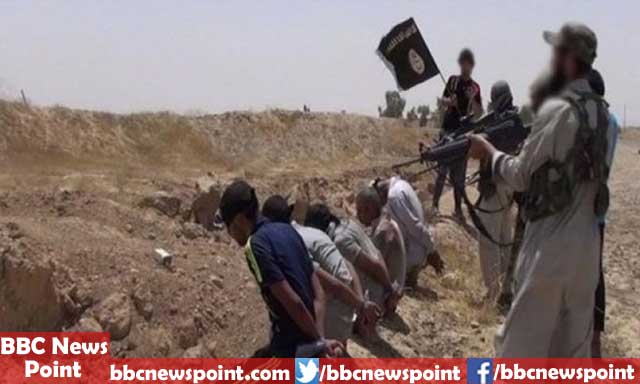 ISIS Attacks in the fall of
2015. Since August 2015, ISIS
launched mass attacks in Beirut, Lebanon; in Ankara, Turkey;
in Paris (killing 130); and on a Russian airliner returning
from Egypt (killing 239). It has also inspired an attack that
killed 14 and wounded scores more in San Bernadino, CA. The
cost of inaction against Assad in 2012 and 2013 keeps
increasing, although as I have noted, the spread of Wahabi
ideology from Saudi Arabia and Taliban ideology from Pakistan
is partly at fault for this.
ISIS Attacks in the fall of
2015. Since August 2015, ISIS
launched mass attacks in Beirut, Lebanon; in Ankara, Turkey;
in Paris (killing 130); and on a Russian airliner returning
from Egypt (killing 239). It has also inspired an attack that
killed 14 and wounded scores more in San Bernadino, CA. The
cost of inaction against Assad in 2012 and 2013 keeps
increasing, although as I have noted, the spread of Wahabi
ideology from Saudi Arabia and Taliban ideology from Pakistan
is partly at fault for this.
Refugee Crisis in 2015 - 2016
By mid-2015, over half of all
Syrians had moved, becoming either internally displaced or
refugees. As millions swelled camps in Jordan, tiny Lebannon, and
Turkey, the World Food Programme
could no longer meet all the need, even with assistance from
the host nations and aid NGOs. Hugh Eakin
of the Pulizer Center reported
that in "2013, 71 percent of the amount needed for
humanitarian aid for Syrians was raised; in 2014, the figure
fell to 57 percent; this year, it stands at just 37 percent.
According to the UN, as many as five million people are now
stuck in 'hard to reach areas' of Syria and not getting any
aid at all."[16]
As a result, the number of
Syrian refugees leaving for Europe over seas of through Turkey
via land routes skyrocked, with
Syrians making up almost 70% of total arrivals to Greece in
the first half of 2015.[17] From July 2014 to
July 2015, there were 210,000 official asylum applications
within EU nations by Syrian (with thousands more who did not
do the paperwork). Swelled by others coming from war-torn
northern Nigeria, Sudan, Somalia, and Afghanistan, the largest
influx of refugees in history since WW II hit Europe in summer
2015. 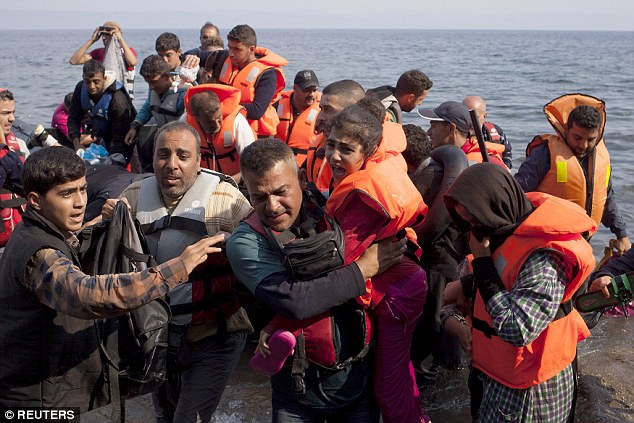
· So many reached Greek islands
that the Greek government had to use large ships to bring them
to the mainland.
· As a result, news coverage of the Syrian war began again on western tv channels, especially after one photo of a drowned Syrian boy picked up from the beach by a Turkish officer went viral.
· It is horrible that our news only covers mass atrocities when they produce an especially emotive image or they materially affect us, but that will continue to be the case as long as we mainly rely on for-profit television.
· The total may exceed 750,000 into Europe during 2015, with almost twice that number expected in 2016 if trends continue.[18]
· The wave of migration prompting extreme reactions from many Europeans already scared that Islamic immigrants will change their culture and/or bring extremists with them.
· Hungary in particular has
erected a razor-wire fence along its borders in a desperate
attempt to stem the tide.
 (Many
Hungarians apparently feel no historical guilt for sending
over half a million Jews to Hitler's camps even
after he was clearly losing the war in 1945).
(Many
Hungarians apparently feel no historical guilt for sending
over half a million Jews to Hitler's camps even
after he was clearly losing the war in 1945).
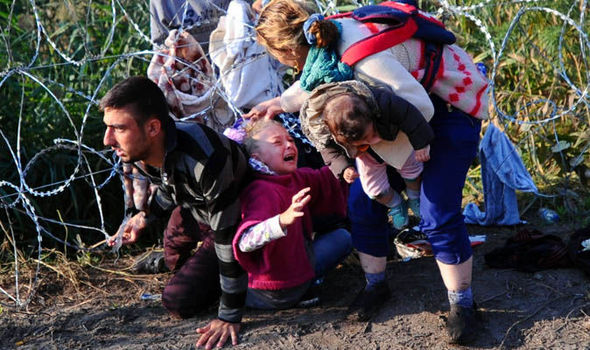

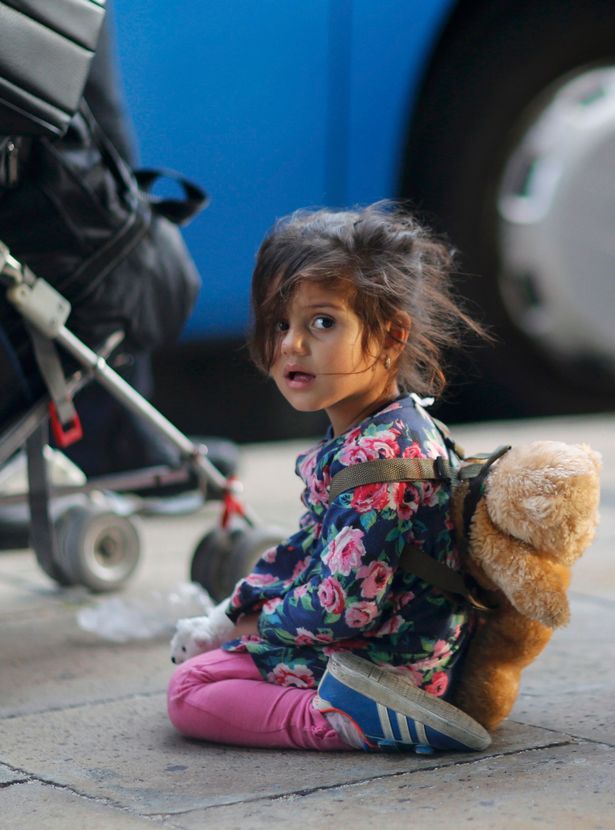
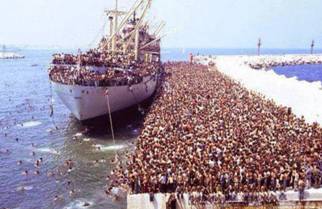

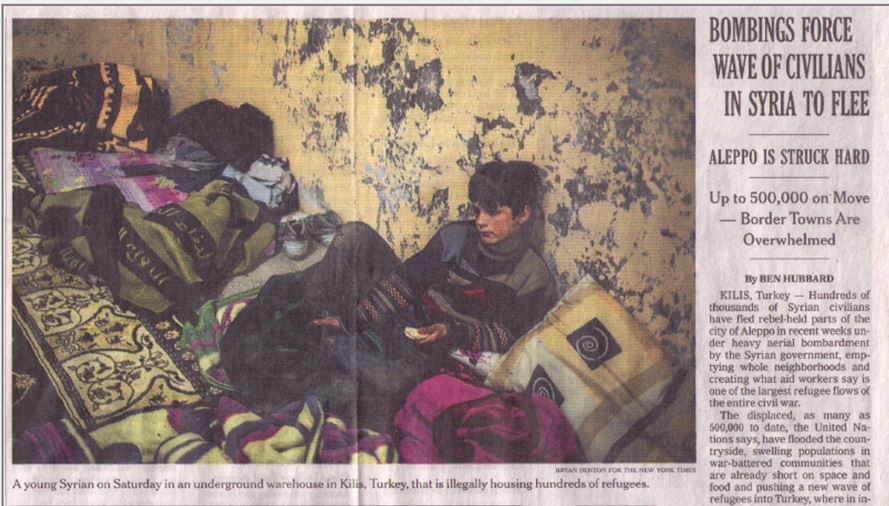
According to the UN High Commission for Refugees, the number
of refugees leaving Syria for other nations by Jan2015 topped
4 million (registered)[12] -- mostly but not
only Sunni. Of course there are many thousands more
unregistered (see map above, from September 2015).
-- By October 2015, that number had grown by another million to over 5 million refugees.
-- As of Oct.2016, the UN High
Commission for Refugees reported 4,810,216 registered
Syrian refugees, and we can be sure that there are
hundreds of thousands more who are not officially registered.
over 700,000 are now crowded in camps within Jordan that have
become small cities.

-- Turkey claims over 2.5
million Syrian refugees, climbing towards 3 million since the
deal with Europe in summer 2016 that closed the route from
Turkey to Lesbos (in Greece).
-- over a million in the tiny nation of Lebanon: fully 1/4 of Lebanon's population
is now refugees from the wholesale destruction of Syria.
Lebanese people have their own Hezbollah faction partly to
thanks for this.
-- Of these, the US admitted under 2500 in 2015, and under
13,000 so far in 2016, for a grand total of less than 16,000
Syrian refugees in the US as of Dec.1, 2016 (see Pew
Research reports). That is .032%, i.e. less than 1/3 of
one percent of the total (despite all Guiliani's and Trump's
truly despicable rhetoric against them).
In this light, the Assad regime's strategy seems to be one of scorched-earth style ethnic cleansing, forcing as much of the Sunni population of Syria as possible to leave. He is succeeding.
In addition, there are over 7 million others
"internally displaced persons" (IDPs) within Syria living with
relatives or in other towns further into the countryside --
straining already slim food supplies. Foreign aid cannot
easily reach these people displaced inside Syria.
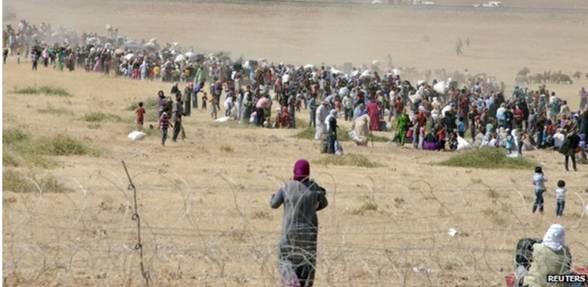 As much as 1/4 of the houses in
Syria are damaged or destroyed; many businesses are gone, and
the national economy is in ruins. Whole areas of some of the
largest cities are abandoned wastelands that look like ruins
of cities that were fire-bombed in WW II.
As much as 1/4 of the houses in
Syria are damaged or destroyed; many businesses are gone, and
the national economy is in ruins. Whole areas of some of the
largest cities are abandoned wastelands that look like ruins
of cities that were fire-bombed in WW II.
8. The flow of refugees from
Syria into Europe began to increase as new routes over the
Mediterranean to Greek isles were plotted by people-smugglers.
Refugees from Afghanistan and some from northeast Africa (e.g.
Somalia and Eritrea) joined the great western trek to Europe.
Many thousands drowned trying to cross the Mediterrean in
overloaded rubber vessels.
-- This inundation led to the rise of far right party strength
across Europe. The old anti-immigrant "National Front" party
in the UK transformed itself into the anti-EU "UKIP" party led
by Nigel Farage and others, and by a margin under 1%, won a
national referendum in mid-2016 calling for the UK to exit the
EU (ironically, another result of Miliband's Aug.2013
treachery).
Russian Invasion and Bombing Sunni civilians (not ISIS) from Oct.2015 on. Attention thus focused on Syria at the September 2016 meeting of the UN General Assembly.
- But during the summer, Russian president Putin sent in forces to create a new Russian air base within Assad-controlled territory, thus increasing the military aid he has already given Assad. He expanded the Russian air base at Latakia on the Mediterranean Sea as well.
- President Obama met with Putin at the UN during the last days of Sept. 2015, and agreed to work against ISIS, rather than criticizing Putin for giving arms and money to Assad to continue bombing his own people. He stopped short of totally capitulating to Putin only by not agreeing to a strategy that allows Assad to stay indefinitely.
- In late Oct. 2015, Assad made an official state visit to Moscow to say thanks for all the help and John Kerry is soon to meet again with his Russian counterpart to look for a political solution that will reward the Russians and Iranians for their atrocities against Sunnis.
Then on Sept.30 and Oct.1, 2015, Russian military aircraft launched from the bases in Syria bombed civilian areas in Homs and other towns in order to damage moderate Free Syrian Army areas. These reports were confirmed by the leader of the Syrian National Coalition on Amanpour's CNN program, who noted that the Russians have simply lied. They have hit targets in Homs, rural areas, and Idlib have killed FSA fighters and civilians. He noted that the Russians are getting their targets from the Assad regime.[19] The Syrian Coalition reported 36 civilian deaths.[20]
On Oct.1, representatives of
the Obama administration from Secretary Kerry and the
President's press secretary to his point man on Syria, General
John Allen, seemed surprised that the Russians would lie like
this! That's pretty amazing, considering that
1. Putin has lied to his own people about Syria and western aggression for years.
2. Putin has lied about whether his soldiers were in Crimea and then eastern Ukraine.
3. Putin has denied that his regime supplied the equipment used to shoot down the Malaysian airliner, when ballistics showed that it could only have been a Russian missile capable of reaching high altitutdes.
4. Putin has blocked four major UN Security Council resolutions on Syria, including even symbolic condemnations.
5. Putin also
supplied weapns to the Syrian regime for years in effort to
ensure the safety of his Latakia base.
The French foreign minister
Laurent Fabius also insisted that
he had made the Russians "promise" only to strike Daesh/ISIS, not the Free Syrian Army
areas. He said let's wait and see if the reports prove to be
true about Russia's targets. He seemed surprised, saying maybe
it will turn out that the Russians' "only aim was to support
Assad" rather than to fight ISIS. We should be surprised at
Fabius's surprise!
On Amanpour Oct.1, 2015, retired General John Allen showed no anger at Putin's atrocities, but just calmly analyzed the Russian move as if it were simply a matter for speculative interest.
+ He simply defended the policy of a building coalition against ISIS that does not propose to fight Assad, as if Assad's acts were not a leading motive for people joining ISIS.
+ Allen also repeated the common vacuous canard that there can "only be a political solution not a military solution" in Syria -- as if Assad or Russia will ever negotiate a political solution without military pressure coming first!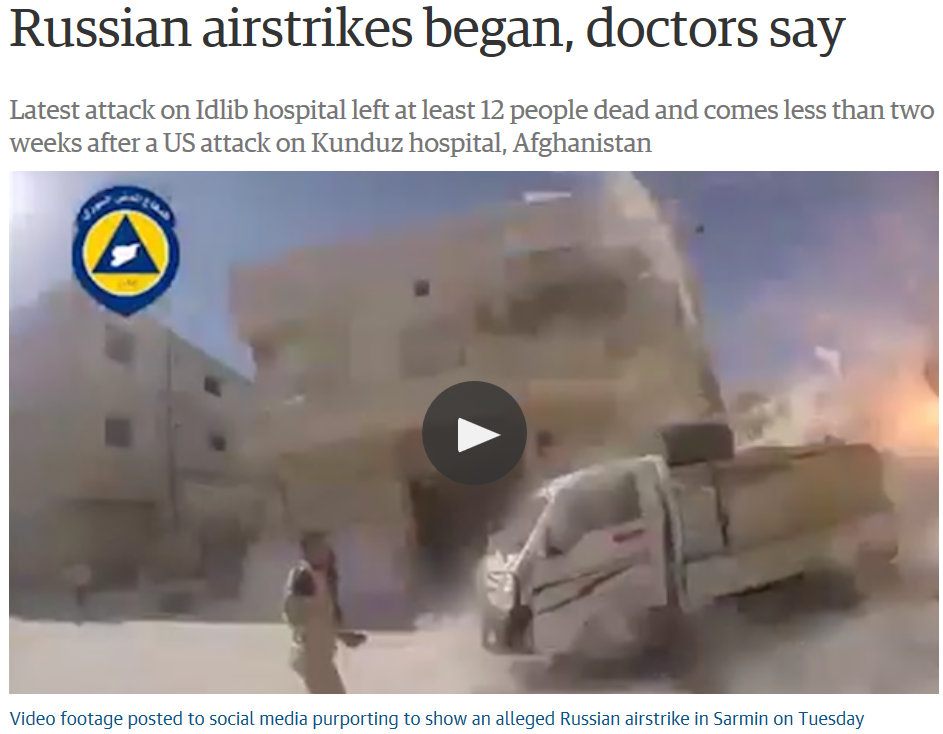
On Amanpour
Oct.20, 2015, Dr. Zaidoun al-Zouabi, head of the Union
of Syrian Medical Relief Orgs, broke down in tears while
trying to describe the horror that the Russian warplanes and
regime helicopters have wrought in bombing Aleppo in recent
days. He noted that three hospitals have been directly hit --
intentionally targeted by Russians (while the Russian
ambassador to the EU is claiming that Russia is targeting ISIS
and Al-Nusra). He also noted that in the last two years, over
150 clinics run by organizations represented by his umbrella
group have been hit. "All we ask is that they spare the
hospitals. Is that too much to ask?" Apparently it it for
Putin. Contrast this with profound US apologies for an
accidental targetting of an MSF clinic in an offensive against
the Taliban-occupied city of Kunduz in Afghanistan.
Analysis
Once again, Putin has taken the initiative and scored gains for his side, i.e. Assad, while the US and our allies sit idle. Putin has successfully used ISIS as an excuse to go into Syria and attack -- not ISIS -- but the moderate FSA forces that are slowly wearing down Assad's minority regime.
- NATO nations have been
utterly crazy to believe Putin's promises.

- We have been foolish to allow him to build two new bases within Syria and supply them with special forces and military jets.
- We let Russia install many
anti-aircraft missile batteries, when ISIS has no aircraft.
- This development now makes it harder for NATO to launch air strikes on Assad's forces if we ever come to our senses and accept the absolute necessity to do so.
- However, Putin has paid no price for his treachery: the Obama administration has done nothing in response to Putin's attacks on Syrian Democratic Forces.
The Fall of Eastern Aleppo.
Since early 2016, Putin's forces have launched wave after wave of bombings (and missile attacks from Russian ships in the Black Sea) against rebel forces and civilians in eastern Aleppo and nearby villages. These attacks have been coordinated with Assad's own air attacks and ground forces -- Assad's army and tanks along with Iranian forces and Russian special forces -- to surround and cut off the remaining rebel-held areas.
- In September 2016, they took and held the last road into/ out of eastern Aleppo; the bombardment escalated on Sept. 22 and in following weeks. By the end of November 2016, they had leveled most of the remaining rebel-held areas (opening the way for ground invasions).
- Thus the last major
rebel-held area of the largest Syrian cities has fallen --
rebel areas of Damascus, Homs, and Hama having long ago been
destroyed.

- This absolutely brutal air campaign has again shocked western audiences, despite being absolutely predictable. The Russian and Syrian air forces have intentionally targeted hospitals and schools, killing hundreds of children.
- By mid-November, the last
working regular hospital in eastern Aleppo had been
destroyed, according to the World Health Organization.
- As the New York Times reported in late Sept., of the 250,000 trapped in Eastern Aleppo, almost 100,000 were children: see http://www.nytimes.com/2016/09/28/world/middleeast/syria-aleppo-children.html
- The UN and US did nothing to stop this assault other than to plead with Russia for weeks to bring about two brief ceasefires. These were intended to bring aid into the city and refugees out of Eastern Aleppo. But many Sunni in that area understandably doubted that the regime would let them leave peacefully.
Western defenders of Assad,
who spread Putin-style propaganda. In short, then, to build a
successful coalition, western nations must strike Assad's
military, perhaps destroying his air force -- rather
than only arming some FSA fighters. But this may be hard for
Americans to understand.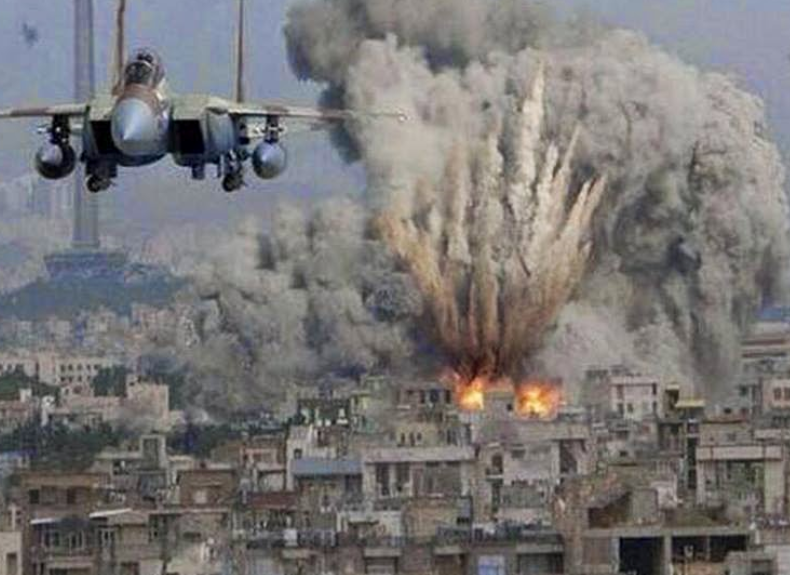
- It may seem contradictory, because Assad is technically at war with ISIS. ISIS does fight Assad forces, recently taking over the last government airbase in the northeast, and shootingdown a regime warplane. The Russian government has also consistently tried to foster the confusion, constantly repeating the lie that the only way to resist ISIS is to support Assad.
- In fact, ISIS is largely a symptom of the chaos and hatreds that Assad has unleashed. How can we possibly expect Sunni groups (including most FSA fighters) to focus on opposing one of the few only Sunni forces (ISIS) that has succeeded to some extent against Assad's Shi'a government, unless we promise to stop the reign of terror by Assad's government against Sunnis in Syria?
- Even though chances would have been better in late 2012 or even Sept. 2013, air strikes could still cripple Assad's air force and change the course of the war. If it were losing ground to FSA forces, who in turn had the breathing space to consolidate their fragmented opposition, even negotiations for Assad to leave Syria and transition power might stand a chance. It would be even better if we held off ISIS on the eastern side while crippling Assad's air power on western side.
- The governments that would most oppose direct attacks on the Assad regime by the new Western coalition against ISIS are Putin's regime in Russia, which has shamelessly defended Assad's interests against UN action throughout the courses of his atrocities, and the Shi'a government of Iran which has sent fighters to help Assad. In both cases, it is hard to see much disadvantage with upsetting these rogue regimes, which are operating contrary to US interests and international law on many fronts.
- And yet many Americans are
hoodwinked by Assad and Putin. To cite just one example,
Representative Tulsi Gabbard (D-HI) argued on MSNBC in early
Oct. 2015 that Putin is basically correct in claiming that
we should support Assad as the best counterweight to ISIS.
It was a sickening display of callous reasoning of the same
kind that Kissinger and other 'cold warriors' used to
produce rationalizations for propping up right-wing
dictators in South America and the Middle East, including
even Saddam Hussein. Nothing good ever came from such narrow
nationalistic betrays of basic human rights. But apart from
such moral considerations, Rep. Gabbard's statements
illustrate how American politicians can be lulled by
flagrant lies when these support what we already want to
believe -- namely that we should do nothing. Notably, Ms.
Gabbard was among those in Congress who, in summer 2013,
spoke against punishing Assad for the ehemical weapons
attacks, thus helping to open the door for ISIS's rise. She proudly displays this
stance on her
website. In early Nov. 2015, Gabbard was cheered by
Bill Maher for making the same atrocious statements on his
show. She in turn agreed with Maher's horrific statement
that we should hope for rival Muslim factions to kill each
other off (which sounds like a hate-filled genocidal wish
more fitting for Glenn Beck than for an avowed defender of
liberal values).
- I would urge people to stop watching Maher's show on HBO, and not to donate to the DNC while Gabbard remains its vice-chair.
- Thus in early 2016, Gabbard found herself in
bed with Ted Cruz and Donald Trump. In the Dec. Republican
primary debate on CNN), Cruz called for allying with Assad
against in order to fight ISIS -- even though Assad had
killed 8-10 times more innocent victims than the Castro
regime which he so vehemently opposes. Thus Cruz plays
right into Putin's propaganda. For his part, Trump has
openly endorsed Putin as a good guy and been praised by
Putin in return (one might wonder if Trump is counting on
business deals with Putin's corrupt cronies, or just envies
Putin's ability to kill journalists who criticize him).

- Crispin Blunt, Tory head of Military Affairs under the prior Cameron administration in the UK, also opposes any kind of intervention to stop Assad. He was one of the main causes that the effort in 2013 failed. Even on Nov.3 of 2015 in a Guardian editorial, he is still arguing that "only negotiation" without any credible threat behind it can ahiceve anything -- the ultimate head-in-the-stand self-deception. See Natalie Nougayrède's brilliant refutation of this desperate canard, also in the Guardian: she is entirely correct that we should have followed what worked in Bosnia in this case rather than leave Syrian Sunnis to the hands of Assad's torturers.
- There are many other shameful
examples of Americans and Europeans who indulge in
conspiracy theories aimed at portraying any efforts to stop
mass atrocities as "western imperialism" while effectively
praising Putin and construing efforts to spread democracy as
"anti-Russian" (as if Russian people have no natural
interest in democratic values). A good example of this
alarming trend of westerners spreading Putinisk propaganda
is Steven
Chovanec's post on mintpress. This nutcase also has
the temerity then to wax poetic about the plight of refugees
flooding into Europe while construing any effort to stop the
main cause as colonial hegemony.
Analysis in early 2016: Are there "moderate" rebels
left? And the plight of other minorities in Syria?
The short answer is absolutely
yes, as real experts on the ground situation constantly
explain. The Economist estimated in mid-2016 that the
Syrian Democratic Forces in the north of Syria aiming to
retake Raqqaa include about 20,000 Kurdish YPG fighters and at
least 10,000 Sunni Arabs, but the latter nuimber has probably
grown since the US started supplying arms and material to this
groups. But there are many more when we include the
remnants of Free Syrian Army forces in the rest of Syria. I
reprint a key fragment of Michael
Stephens' Dec.1, 2015 report on the BBC website here:
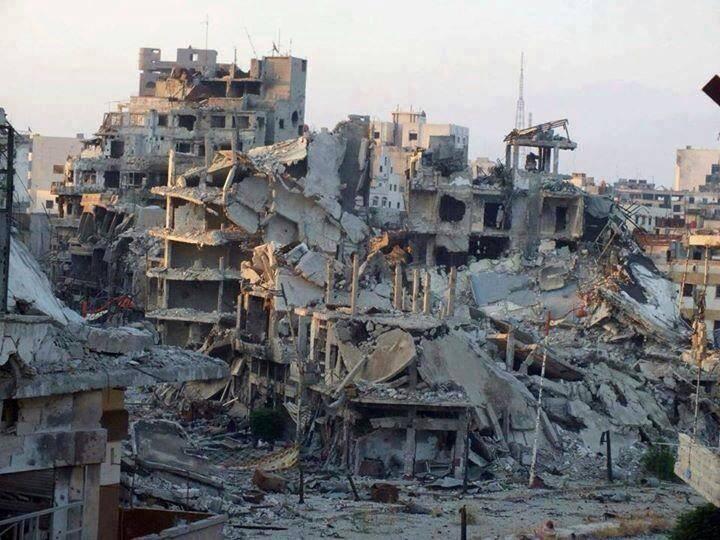
So some of these groups are
more fundamentalist than others. Stephens also notes 40,000 -
50,000 Kurdish forces in northern Syria, but there would be
more with ISIS removed from Mosul in Iraq. Stephens' figures
also do not appear to count roughly 10,000 Turkmen fighters
who also oppose both Assad and ISIS.

As to alleged radicalization of some formerly moderate rebels, it is not surprising that after four years of trying to use small arms to resist a regime attacking thousands of civilians daily with heavy artillery and aircraft, the more moderate goals and ideals of the initial rebellion against Assad have been eclipsed by desperation on the Sunni side, with many who initially served the Free Syrian army going to more extreme groups united around more officially "Islamic" goals -- something religious sentiment is all that an utterly despoiled people have left. Thus, while I much-respect Prof David Bromwich of Yale for his illuminating work on Middle East politics, I feel that he is too unsympathetic with the desperate straits into which moderate groups have been pushed by being left to swing in the wind (even while sources he quotes note that more secular groups now "have no choice" but to fight alongside Al-Nursa if they wish to resist Assad effectively. Still, as a result, some Sunni other than ISIS and Al-Nusra have done some horrific things as well:
- Alleged examples include the desperation measure of using captured Shi'a women as human shields, as this "anti-Guardian" website purports to show. While I abhor this tactic, though, it is also somewhat understandable when faced with constant regime bombardment of civilian housing. There is a difficult question of when, if ever, such tactics could be justified by way of reprisals for Assad's massive war crimes. But I do not try to answer such questions in the challenging area of reprisal-doctrine on this page.
- However, I must also note
that this website seems to be highly biased and
unobjective. For example, it claims, absurdly, that all
rebels in Syria fighting Assad are "western-backed
mercenaries," which sounds like Russian propaganda. The
site is advertised on pro-Putin
webpages as well, and it hosts lots specious
pro-Putin arguments. I include the report of human-shield
use nevertheless because it is an important allegation,
even though direct military strikes on civilians are far
worse war crimes.
- More reliable info from the Vatican
network says that Sunni fighters in Aleppo regularly
hit areas populated with Christian minorities, sometimes
including churches. There is no doubt that members of this
minority are generally now seen by Sunni rebels as siding
with Assad, who has fought to reopen roads into southern
Aleppo that supply areas of the city friendly to him. It is
a vicious circle, because the Sunni rebels' anger motivates
them to strike out at any group that supports their
oppressor. But that only confirms the fear of Christian
minority groups that they need Assad to protect them.
- If the Sunni rebels groups were not so fractured into different bands with loyalties to different movements -- i.e. if we had supported the Free Syrian Army as the leading opposition to Assad -- they could potentially have reached out to Christian minority groups in Syria to ensure their protection in exchange for abandoning support of Assad.
- Among Sunni rebel groups, Ahrar
al-Sham is getting more attention recently as a
powerful group in the grey zone: it is Islamicist, and
promised to institute Shar'ia law, although it is more
moderate than Al Nusra or Al Qaeda. I came to the "grey
zone" label myself, but was interested to see Ambassor
Robert Ford apply it as quoted as well in this
NYT article.
- Christians in Syria
originally numbered as much as 2 million souls, though of
course many have now fled. A student I have met from a
Christian community in Aleppo reports that over 700,000 have
now fled Syria. Christians in the nation are predominately
made up of Catholics and Orthodox Christians, including many
of Greek and Syriac Orthodox descent, but also Armenian
Orthodox Christians. Many were originally concentrated in
Aleppo. Catholic Christians include the Maronites, who are
also found in Lebannon,
- Another embattled minority
are the Druze, a distinctive unitarian and theospanical
group that is neither Christian nor Muslim. With other 1
million originally in 21st century Syria, mainly in the
southwest, they have supplied many officers to the Assad
army, and thus are hated by many Sunni rebel groups. ISIS
have targetted Druze communities.

Republican Know-Nothings on
Muslim Refugees. As a result, a new backlash against
Islmamc immigrants has spread across the western hemisphere,
with Syrian refugees in particular being targetted. Several
Republicans campaiging for President have said truly appaling
things about Syrian refugees, with Donald Trump asserting that
he would not even allow orphans and old women from Syria into
the US. Trump has even called for new "internment camps" for
Muslims! Ted Cruz has made similar horrendous remarks, and
even Chris Chistie, governor of New Jersey, has opposed
accepting any Syrian immigrants in his state.
- Still, in the US, probably the most appalling example has
been former mayor Rudi Guiliani, who has stumped for Trump
around the nation in 2016 mainly by arguing that we should
oppose taking in any Syrian refugees because 10% of them or
more couple be terrorists (despite the fact that not a single
one of the 16,000 so far in the US has proven to be a
terrorist). Sickeningly, Guiliani portrays himself as a good
Christian who is supporting Trump, another good Christian.
- These politicians are cowards who would let ISIS and Al Qaeda win in their effort to alienate all Muslims from western governments and values.
- They flout the fundamental human right to asylum, while pretending to espouse universal values and even a libertarian ideology that insists on a human right to exit one's birth-nation.
- They prefer a small illusory increment of safety over the most minimal decency to some of the most oppressed people on Earth.
- They should be compared to FDR when he turned away several thousand Jewish refugees seeking asylum in the late 1930s -- his most despicable act as President.
- Of course, the lies about Syrian refugees being terrorists have increased since Trump was sworn in as President.
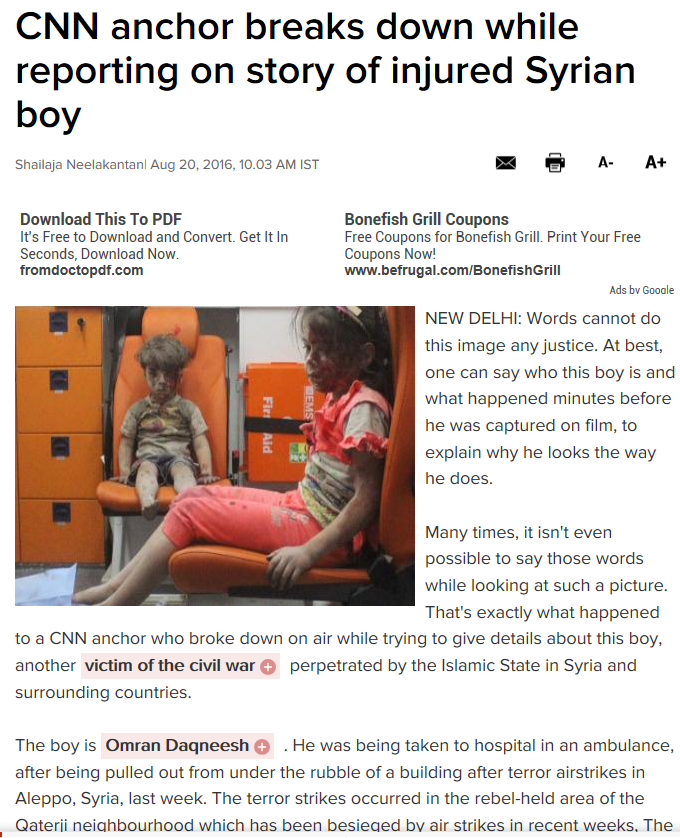
These Republicans are returning
their party to the days when it was associated with the
"Know-Nothings" of the mid-19th century who hated German and
Irish immigrants, until Abraham Lincoln insisted on rejecting
the Know-nothing wing and their ignorant bigotries. This truly
shameful spectacle suggests that there is no level of
selfishness, ignorance, and hatred to which politicians like
Cruz and Trump will not stoop in effort to pander to the dregs
of American society.[21]
Summation: the Moral Toll to Date (circa Jan.20, 2017)
Syria's neighboring nations such as Turkey and Jordan, along with other Sunni-majority nations such as Egypt and Saudi Arabia, have refused to mount an air or ground war against Assad without help from Europe and the US, and they bear primary responsibility for this -- just as Saudi Arabia is responisible for allowing the spread of Wahabi teachings to inspire terrorist groups. Yet the refusal of western nations to form a coalition with these Arab states to intervene in Syria has led to all the following catastrophic consequences:
- The crucial moral precedent established in Bosnia, Kosovo, and Libya -- that governing regimes may not slaughter their own people en mass-- is being lost.
- The fledgling doctrine of the
Responsibility to Protect (R2P) -- developed with so much
effort following the Rwanda catastrophe -- which was adopted
by the UN in 2005, is dying on the vine. We have not even
taken the small step of establishing a no-fly zone, which
would have prevented the Russian intervention.
- As a result, we are emboldening tyrants around the world to engage in mass murder and ethnic cleansing whenever it suits their desires, with confidence of impunity. For example, the rampages of the Janjaweed militias throughout Darfur have resumed in the last three years under this new sense that democratic nations with large militaries just do not care.
- We have emboldened an
expansionist, ultra-nationalist Russian regime to take the
course of mass propaganda and stirring ethnic hatred to
achieve its perceived strategic advantages. Whereas the fall
of Assad's regime would significantly have weakened Putin,
his perceived "win" over Obama in Syria in fall 2013 lead to
his greater confidence that he could control Ukraine -- and
when that failed, his sense that he could take Crimea with
impunity. He has since expanded his military reach into
Syria itself.
We have also missed a crucial chance to check Iran's expansion of its power westward beyond the western edges of Bagdad, and left our Kurdish allies without significant support.
- By leaving Iraq in control of a Shi'ia majority party that has refused to include Sunnis and other minorities, and leaving Assad in power in Syria, while strengthening Hezbollah's position in Lebannon, we have allowed the formation of a Shi'ia Arc of Domination from Tehran all the way across the northern Middle East to the Lebanese coast. Thus we have further enflamed Sunni hatred of the United States, and squandered the chance to show Sunnis that we can support their side when they are the victims of minority-rule tyranny.
- By leaving a power-vacuum in Syria, we have encouraged Sunni radicalist groups from across the region to make their way there, making it much harder for the crisis to be resolved in a way that leaves a pluralistic nation intact with room for religious minorities many backgrounds.
- And finally, we have left the
door open to a wider regional war between Sunni and Shi'ia throughout the Middle East --
a conflict that could end up going on for decades, like the
horrific 30 Years War in European history, but fought with
helicopters, shoulder-fired rockets, Scud missiles and
chemical weapons. The ongoing and highly destructive civil
war in Yemen is a further sign of this spreading crisis.
My own opinion is that these outcomes in Syria are clearly a great failure in our foreign policy, aided and abetted by many short-sighted politicians and activists in the US and Europe. Every American should be deeply ashamed that we stood idly by and allowed our brothers and sisters to be slaughtered like animals in a shooting range by Assad, the Iranian guard, and now Putin's aircraft and missiles. If these results stand unaltered, historians will look back on them as a collosal mistake with permanent consequences, turning back the progress of human rights ideals in the 21st century. Just as Bill Clinton has said that inaction in Rwanda is the error he most regrets, Obama will say in time that if there is one thing he could go back and change, it would be to act decivisely against Assad.
What is the Solution?
Politicians talks of a no-fly zone in northern Syria, which would
be a good idea, though it would have been easier to implement in
2012 than now. They also talk of the need for a political
solution, although no such solution is now possible without
Assad's military defeat. Moreover, it is clear that Syria can
never be one country as it was before after carnage and
destruction of this magnitude. The same holds for Iraq, where
developments since the US exit have divided Sunni, Shi'a, and Kurd
too deeply to be reunited in the foreseeable future.
Therefore, my belief is that a
long-term solution is possible only with partition of both Iraq
and Syria. The main goal should be to give the Sunnis in both
nations a new homeland in which they can be secure as the
majority in control. Only this way can a Sunni peoples in these
regions be confident of their security without running to ISIS
or Al Qaeda. A new Sunni-majority nation is the key to
eradicating ISIS's areas of control. A secondary aim should be
to give the Kurds their own nation as well. In their fight
against ISIS, with virtually no assistance from the Shi'a
government in Iraq, have more-than earned it. They have also
greatly aided Turkey's interests, even while the Turkish
government has continued its war against Kurdish separatists.
Finally, the Shi'a and other minorities in cities and towns of
western Syria must be protected. I suggest a partition that
looks something like the following:

But no viable solution of this kind can come about solely at the
negotiating table. It requires force, both against Assad and
against ISIS. To conquer ISIS in particular requires armies
closing in from four sides: a Kurdish army from the northeast, a
Turkish army from the north, an allied Saudi-Egyptian-European
army from the west around Damascus, and a Jordanian-US-Iraqi
army from the southeast. That requires control of the territory
to ISIS's west in Syria or else they will simply retreat into
the Syrian cities where is will be even harder to dislodge them.
Contast this proposal with the useless plan endorsed by the
Obama Administration, as it inches closer to working with Putin
and Lavrov on coddling murderous tyants. From the BBC summary,
here is the celebrated UNSC resolution of Dec.17, 2015:

Rebuttal:
- Why would Sunni groups cease fire to promote negotiations with a regime that has already, three times, simply used international peace conferences as cover for carrying out new waves of atrocities? The Assad regime is in a stronger position than in in Jan. 2014 when it refused to concede anything; now Assad is backed by Russian aircraft, in addition to Iran and Hezbollah.
- Assad's regime and Russia will continue to attack all moderate Sunni groups, branding them all "terrorists" in their continuing effort to reduce this crucial term to meaninglessness.
- The UN could not monitor anything, let alone enforce any credible peace plan, without putting 50,000 peace enforcement troops on the ground in Syria. Which nations will volunteer for that mission?
- Last and most importantly, WHO in Syria is going to vote for WHAT? The idea that any election could be held in a nation wracked by mass murder with a quarter of its population moved abroad and another quarter internally displaced is absurd beyond belief (and what of those living under ISIS-controlled areas?). Only a hollow cipher of a human being stripped of every last vestige of conscience could sell such a plan: so Sergei Lavrov is just the guy for this task! Only a complete fool could seriously believe that this would mean anything other than Assad's regime certifying groups loyal to it as eligible to vote.
- And is this supposed to be an election for a single nation, a single Syria, now, after all this?? The very proposal is an atrocity that betrays no comprehension of the enormity of what has happened: a mind that could believe this has never traveled down the river into the Heart of Darkness and gleaned the barest inkling of what real horror is; even Kurtz had more authenticity.
- No Sunni could possibly now live in a Shi'a-led single Syria without terror, which will continue to send recruits to ISIS and allied groups. And Shi'a groups along with Christians and other minorities have sufficient reason, as we have seen, to fear any Sunni-led government as likely to promote or allow reprisals against them, whatever promises of moderation there are. Either of these results will lead to a further mass exodus.
Back
to my main page at Fordham University
last update Jan.15, 2017
[1] The EU website syrianrefugees.eu has not been updated since Feb.2014. But it reported at that time that "An estimated 9 million Syrians have fled their homes since the outbreak of civil war in March 2011, taking refuge in neighbouring countries or within Syria itself. According to the United Nations High Commissioner for Refugees (UNHCR), about 2.5 million have fled to Syria's immediate neighbours Turkey, Lebanon, Jordan and Iraq. 6.5 million are internally displaced within Syria. Meanwhile, under 100,000 have declared asylum in Europe with a small number offered resettlement by countries such as Germany and Sweden." The totals are higher now 8 months on.
[2] As of April 16, 2015, the Syrian Observatory for Human Rights estimated 310,000 dead, and we can be sure the figure is higher than that several months later: http://www.syriahr.com/en/2015/04/310000-people-killed-since-the-beginning-of-the-syrian-revolution/. In December 2014, the Director of the Syrian Observatory for Human Rights estimated 280,000 killed: see http://www.washingtonpost.com/blogs/worldviews/wp/2014/12/03/200000-dead-why-syrias-rising-death-toll-is-so-divisive/. In the Weds. Sept.18 meeting of the Senate Foreign Relations Committee in Washington, D.C., Senator John McCain cited the figure of "more than 190,000."
[3] Photo from "Syria's 4-year march toward destruction," http://yalibnan.com/2015/03/09/syrias-4-year-march-toward-destruction/
[4] http://www.newsweek.com/how-syrias-assad-helped-forge-isis-255631
[5] http://www.theguardian.com/world/2012/sep/07/syria-daraya-massacre-ghost-town
[6] http://www.bbc.com/news/world-middle-east-23927399
[7] www.theguardian.com/world/2013/aug/29/syria-ed-miliband-succour-assad
[8] http://www.dailymail.co.uk/news/article-2407611/Now-Ed-Miliband-says-weve-got-help-Syrians-Labour-leader-says-PM-ways-end-slaughter-Syria
[9] http://www.theguardian.com/politics/2013/sep/02/clegg-miliband-british-intervention-syria
[10] http://www.democraticunderground.com/10023622704
[11] http://www.washingtonpost.com/blogs/monkey-cage/wp/2014/05/12/why-are-fighters-leaving-the-free-syrian-army/
[12]http://www.unrefugees.org/2015/07/total-number-of-syrian-refugees-exceeds-four-million-for-first-time/?gclid=CICA7fq2osgCFc2QHwodYU8PRg&gclsrc=aw.ds. This is an increase from 3 million in mid-2014, showing that the tide keeps increasing. http://data.unhcr.org/syrianrefugees/regional.php
[13] See the interview on CNN with Professor Henri Barkley of Lehigh University, Sept. 21, 2014: http://transcripts.cnn.com/TRANSCRIPTS/0210/14/se.07.html
[14] See the story on the Iraqi Kurds in the New York Times, Sunday Sept.21, 2014, p.A8.
[15] I write this as someone who voted for Obama in both 2008 and 2012.
[16] Eakin, "Europe: the Terrible Flight from the Killing:" http://pulitzercenter.org/reporting/syria-terrible-flight-killing
[17] See the Economist analysis at http://www.economist.com/blogs/economist-explains/2015/09/economist-explains-4
[18] From UNHCR reports: see http://www.france24.com/en/20151001-unhcr-expects-more-refugees-migrants-arrive-europe-2015-2016
[19] http://www.cnn.com/videos/world/2015/10/01/khoja-intv-amanpour-syria-opposition-russia.cnn/video/playlists/amanpour/
[20] http://en.etilaf.org/